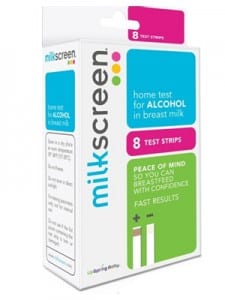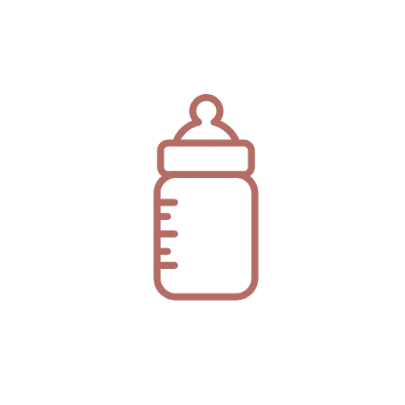
Milkscreens are intended for use by consumers at home as a qualitative test to identify the presence of alcohol in breastmilk. They detect at a level of 0.02% or greater.
Alcohol can pass through your body into your breastmilk. Because everyone metabolizes alcohol differently, the amount of time it takes for the alcohol to leave your breastmilk also varies. Alcohol is not trapped in breastmilk and draining your breasts will not speed up the elimination of breastmilk from your system. Over time your body will naturally metabolize the alcohol but the only way to know for certain that the alcohol is gone is to test your milk.
The MilkScreen test accurately detects the presence of alcohol at 0.02% or greater. This ia a level of alcohol that according to leading medical studies may negatively impact on baby’s sleeping and eating behaviors.
The milkscreen consists of a plastic test strip with a reactive pad attached to the tip. The tip, on contact with breastmilk that contains alcohol, will change colour depending on the amount of alcohol present.
Directions:
- Express milk directly onto the milkscreen test pad, or in a container. If you choose to express milk into a container make sure the container is clean, dry, and entirely free of alcohol.
- Because alcohol levels can continue to rise in milk for 30-90 minutes after the last alcohol drink, milk collection should be done at least 30 minutes after your last drink.
- Saturate the test pad with breast milk OR dip the test pad into a small portion of milk from a pumped sample. Remove the test strip from the container after 3 seconds. Discard milk.
- Tap the exess milk of the test pad.
- Wait 2 minutes.
- Read the results by comparing the colour on your test pad to the colour blocks on the back of the box.
- If you obtain a POSITIVE result, wait and re-test after 30 minutes using a fresh sample. Do not feed baby with this milk.
Limits
The results are for the qualitative detection of alcohol in breast milk. Drinking large amounts of alcohol is dangerous for you and your baby. The test is meant to detect residual alcohol from an occasional drink, not as permission for heavy or frequent alcohol consumption.
The test strips are very sensitive to the presence of alcohol and alcohol vapours in the air could be detected by the test. If the presence of alcohol vapours is suspected, the test should be used in an area known to be free of these vapours (e.g outside).








